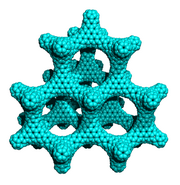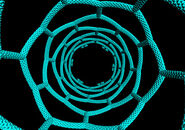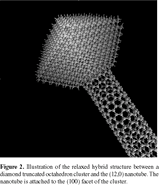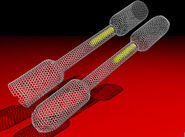Nanotechnology is a field where scientists try to manipulate the individual atoms and molecules of matter.
Routes to nanotech[]
- One route to nanotechnology is through continuous miniaturization (top-down)
- Another through atomic and molecular simulation, designing simple machines (like the ubiquitous nano-bearings) and then building anything the carbon-mechanical way
- Or through understanding of molecular biology, solving the proteinomics challenge and using "natural" molecular machines - the RNA, DNA, ribosomes and proteins.
State of the art developments (in molecular manufacturing)[]
- "Nanocar" consisting of a few molecules that has a photon-powered motor and can (in simulation) travel on a surface
- DNA machine that detect viruses by reading their genome and then synthesizes a fluorescent protein causing a visible glow [1]
- If you examine the announcement in more detail, it looks closer to standard biotechnology than the description makes it sound. The biotechnology combines a 'trigger' with an 'action'. For the action we are re-using existing machinery, Bioluminescence, but we could attach other useful pre-existing enzymes instead. An enzyme producing substances that makes the cell 'sticky' would be another good choice because it would lead to very simple method for sorting infected from uninfected cells. For the trigger, a DNA sequence match is our best bet. We can precisely control the sequence and hence the complementary sequence which it matches. Note that constructing this kind of DNA machine is very different from a 'universal assembler' which places atoms or groups of atoms one at a time.
- Simulated molecular parts consisting of 20000+ atoms

Blue - lead, red - silicon, green - tin
Atomic force microscopes can be used to recognize different atoms. [2]
Milestones[]
Three milestones [3]:
- Basic molecular manufacturing: The precise formation of molecular structures under direct mechanical control.
- Exponential molecular manufacturing: The use of nanoscale molecular manufacturing tools to build more of themselves, making it possible to produce large quantities of product.
- Integrated molecular manufacturing: The integration of tools into massively parallel structures, nanofactories, that can combine their outputs into large products.
Applications[]
Nano Materials[]
Nanotechnology has the potential to create Light Weight Super Strong Materials.
Nanobots[]
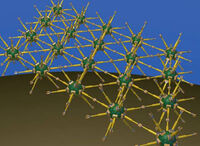
Nanorobotics is the technology of creating machines or robots at or close to the scale of a nanometre (10-9 metres). More specifically, nanorobotics refers to the still largely hypothetical nanotechnology engineering discipline of designing and building nanorobots. Nanorobots (nanobots, nanoids or nanites) would be typically devices ranging in size from 0.1-10 micrometres and constructed of nanoscale or molecular components. As no artificial non-biological nanorobots have so far been created, they remain a hypothetical concept at this time.
Nano computers[]

Pascaline

Nano version
Nanomechanical computers may be built, using the principles first put forward in 17th century by Pascal and others, but at the nano level. Such nanocomputers will be incredibly powerful. Simulations proving that this approach will almost certainly work, can be done by any interested reader.
Timeline[]
A notional timeline from WiseNano Wiki places the development of self-replicating nanotech in 2020. However, the years are mostly for illustrative purposes and the author is not confident they are correct.
- 2005 — Shaped crystal (diamondoid) manufacturing
- 2006 — Super Thread [4]
- 2008 — Simple products manufactured through nanotech
- 2010 — Complex products manufactured through nanotech
- 2013 — Reprogrammable nanofactories
- 2020 — Self-replicating nanofactories or nanorobots (nanoassemblers)
ICTAF (Tel Aviv University) made a forecast of progress in nano [5] (full report - PDF) with specific predictions:
- 2015 — biosensors capable of detecting a single molecule
- 2020 — direct construction of artificial human organs
- 2025 — use of nanomachines inside the body for diagnosis and therapy
by Brian Wang:
- 2008-2011 - M5 Fiber 9.8 Gpa
- 2014-2018 - Carbon nanotube fiber inexpensive and with over 50GPa tensile strength
- 2008-2012 - Gecko mimicing wallcrawling suits for military and enthusiasts
External links[]
- WiseNano Wiki
- Nanotech Now
- HumansFuture - Nanotechnology
- Nanotechnology at FutureTAG wiki (Site down)
- Nanofactory Collaboration
- Nano-assembler bootstrap [6], Nanofactory [7]
- NanoConferences.com
- The Nano Age
Some of the applications of nanotech[]
- Food - In ice creams, fat globules a few nanometers across have all the taste of larger globules, because of greater surface area, and less fat. In cooking oils nano-scale zeolite helps to prevent the fat breaking down at high temperature.
- Military
- Cryonics
- Aging
- Space elevator
- Medicine
- Weapons of Mass Destruction
- Jupiter Brains/Matrioshka Brain
- Computing (A laptop of 1 Billion CPU)
- Dyson Sphere
- Transhumanism
- Virtual Reality
- Uploading
- Data Storage
- Display
- Energy
- Packaging
- Electronics
- Bio Detectors
- Catalysts
- Cosmetics
- Communication
- Textiles
- Environmental and pollution monitoring
- Under the skin human and animal health monitoring systems
- Surveillance Systems
- System monitoring of mechanical systems and oils
See also[]
- Nanotech Age, the age where nanotechnology eliminates all pollution and people prepare their exodus from Earth.

